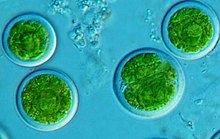
Back تريبوكسيا ARZ Трэбуксія Byelorussian ট্রেবুক্সিয়া Bengali/Bangla Trebouxia CEB Trebouxia Czech Trebouxia German Trebouxia Basque Trebouxia French Требуксия Russian Требуксія Ukrainian
| Trebouxia | |
|---|---|

| |
| Scientific classification | |
| (unranked): | Viridiplantae |
| Division: | Chlorophyta |
| Class: | Trebouxiophyceae |
| Order: | Trebouxiales |
| Family: | Trebouxiaceae |
| Genus: | Trebouxia Puymaly |
| Type species | |
| Trebouxia arboricola Puymaly
| |
| Species | |
| |
| Synonyms | |
| |
Trebouxia is a unicellular green alga.[1] It is a photosynthetic organism that can exist in almost all habitats found in polar, tropical, and temperate regions.[2][3][4][5][6] It can either exist in a symbiotic relationship with fungi in the form of lichen or it can survive independently as a free-living organism alone or in colonies.[7] Trebouxia is the most common photobiont in extant lichens.[8] It is a primary producer of marine, freshwater and terrestrial ecosystems.[3] It uses carotenoids and chlorophyll a and b to harvest energy from the sun and provide nutrients to various animals and insects.[2][4]
An ancestor of Trebouxia may have introduced photosynthesis into terrestrial habitats approximately 450 million years ago.[9] It is also a bioindicator of habitat disturbances, freshwater quality, air pollution, carbon dioxide concentration, and climate change.[10][11] Furthermore, its life cycle is complex and much research needs to be done to characterize it more completely.[12][13][14][15][1][5] For decades, the presence of sexual reproduction was unknown.[16] However, recent (2000s) molecular evidence of recombination and the observation of sexual fusions of gametes to form zygotes suggest that sexual reproduction occurs.[5]
Trebouxia (as circumscribed in 1994) is a paraphyletic group;[17] the issue was resolved by moving some members to Asterochloris.[18] Horizontal gene transfer of protein encoding genes between fungi and Trebouxia is known to have occurred.[19][5] There is also evidence of intron horizontal gene transfer among different strains of Trebouxia in lichen thalli.[5] The presence of globose cells in fossil lichens from the Lower Devonian period (415 million years ago) that look similar to Trebouxia indicate the significance of Trebouxia-like fungal symbiosis throughout the terrestrial history of Earth.[8]
- ^ a b Silverside, AJ (2009). "Trebouxia (images of British biodiversity)". Archived from the original on 2016-03-04. Retrieved 4 March 2016.
- ^ a b Erokhina, L. G., Shatilovich, A. V., Kaminskaya, O. P., & Gilichinskii, D. A. (2004). Spectral Properties of the Green Alga Trebouxia, a Phycobiont of Cryptoendolithic Lichens in the Antarctic Dry Valley. Microbiology,73(4), 420-424. doi:10.1023/b:mici.0000036987.18559
- ^ a b Lukesova, A., & Frouz, J. (2007). Soil and Freshwater Micro-Algae as a Food Source for Invertebrates in Extreme Environments. Cellular Origin, Life in Extreme Habitats and Astrobiology Algae and Cyanobacteria in Extreme Environments,265-284. doi:10.1007/978-1-4020-6112-7_14
- ^ a b Seckbach, J. (2007). Algae and cyanobacteria in extreme environments. Dordrecht: Springer. doi:10.1007/978-1-4020-6112-7
- ^ a b c d e Seckbach, J. (2002). Symbiosis: Mechanisms and model systems. Dordrecht: Kluwer Academic.
- ^ John, D. M., Whitton, B. A., & Brook, A. J. (2002). The freshwater algal flora of the British Isles: An identification guide to freshwater and terrestrial algae. Cambridge: Cambridge University Press.
- ^ Bubrick, P., Galun, M., & Frensdorff, A. (1984). Observations On Free-Living Trebouxia De Puymalyand Pseudotrebouxia Archibald, And Evidence That Both Symbionts From Xanthoria Parietina (L.) Th. Fr. Can Be Found Free-Living In Nature. New Phytologist,97(3), 455-462. doi:10.1111/j.1469-8137.1984.tb03611.x
- ^ a b Honegger, R (2018). "Fossil lichens from the Lower Devonian and their bacterial and fungal epi- and endobionts". Biodiversity and Ecology of Fungi, Lichens, and Mosses. 34. Vienna: Austrian Academy of Sciences: 547–563. Retrieved March 2, 2019.
- ^ Horwath, W. R. (2017). The Role of the Soil Microbial Biomass in Cycling Nutrients. In T. K. Russel (Author), Microbial Biomass: A Paradigm Shift In Terrestrial Biogeochemistry(pp. 1-348). World Scientific. doi:10.1142/q0038
- ^ Ismail, Asmida; Marzuki, Sarah; Mohd Yusof, Nordiana; Buyong, Faeiza; Mohd Said, Mohd; Sigh, Harinder; Zulkifli, Amyrul (7 March 2017). "Epiphytic Terrestrial Algae (Trebouxia sp.) as a Biomarker Using the Free-Air-Carbon Dioxide-Enrichment (FACE) System". Biology. 6 (4): 19. doi:10.3390/biology6010019. PMID 28272328.
- ^ Taylor, T. N., Krings, M., & Taylor, E. L. (2015). Lichens. Fossil Fungi,201-220. doi:10.1016/b978-0-12-387731-4.00010-4
- ^ Ahmadjian, V. (1960). Some New and Interesting Species of Trebouxia, a Genus of Lichenized Algae. American Journal of Botany,47(8), 677. doi:10.2307/2439519
- ^ Friedl, T. (1993). New Aspects of the Reproduction by Autospores in the Lichen Alga Trebouxia (Microthamniales, Chlorophyta). Archiv Für Protistenkunde,143(1-3), 153-161. doi:10.1016/s0003-9365(11)80284-8
- ^ Melkonian, M., & Peveling, E. (1987). Zoospore ultrastructure in species ofTrebouxia and Pseudotrebouxia (Chlorophyta). Plant Systematics and Evolution,158(2-4), 183-210. doi:10.1007/bf00936344
- ^ Sanders, W. B. (2005). Observing microscopic phases of lichen life cycles on transparent substrata placed in situ. The Lichenologist,37(05), 373-382. doi:10.1017/s0024282905015070
- ^ Kroken, S., & Taylor, J. W. (2000). Phylogenetic Species, Reproductive Mode, and Specificity of the Green Alga Trebouxia Forming Lichens with the Fungal GenusLetharia. The Bryologist,103(4), 645-660. [[doi:10.1639/0007-2745(2000)103[0645:psrmas]2.0.co;2]]
- ^ Friedl, Thomas; Zeltner, Cornelia (June 1994). "Assessing The Relationships Of Some Coccoid Green Lichen Algae And The Microthamniales (Chlorophyta) With 18S Ribosomal RNA GENE SEQUENCE COMPARISONS 1". Journal of Phycology. 30 (3): 500–506. Bibcode:1994JPcgy..30..500F. doi:10.1111/j.0022-3646.1994.00500.x. S2CID 83976513.
- ^ Skaloud, Pavel; Peksa, Ondrej (2010). "Evolutionary inferences based on ITS rDNA and actin sequences reveal extensive diversity of the common lichen alga Asterochloris (Trebouxiophyceae, Chlorophyta)" (PDF). Molecular Phylogenetics and Evolution. 54 (1): 36–46. doi:10.1016/j.ympev.2009.09.035. PMID 19853051.
- ^ Beck, A., Divakar, P. K., Zhang, N., Molina, M. C., & Struwe, L. (2014). Evidence of ancient horizontal gene transfer between fungi and the terrestrial alga Trebouxia. Organisms Diversity & Evolution,15(2), 235-248. doi:10.1007/s13127-014-0199-x
© MMXXIII Rich X Search. We shall prevail. All rights reserved. Rich X Search